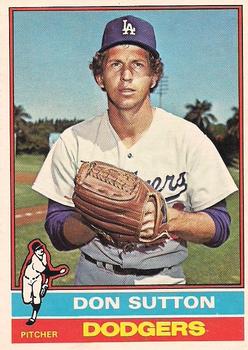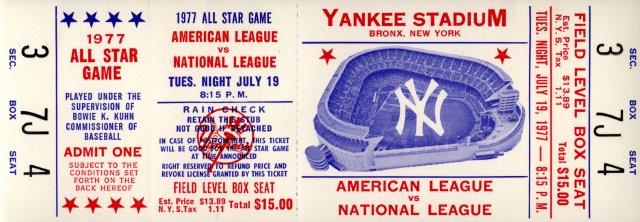July 19, 1977: Sutton Place: Dodger Don dominates AL in Yankee Stadium debut
The New York City hosting the 1977 All-Star Game had drastically changed in the 13 years since the Mets hosted the 1964 Midsummer Classic. In the summer of ’77, Big Apple residents lived in fear of the “Son of Sam” serial killer stalking the outer boroughs, and on July 13, the entire city was plunged into a blackout – interrupting the sixth inning of a Mets-Cubs game at Shea Stadium – and unprecedented looting resulting in a $300 million loss. To top it off, New York was sweltering in 102-degree heat on the afternoon of July 19, a record high for the date.1
The American League entered the contest having lost 13 of the last 14 All-Star Games. Junior circuit manager Billy Martin, who had played in the 1956 All-Star Game for the Yankees, saw two of his potential starting pitchers for the game unavailable because of injuries. Mark Fidrych, the Tigers’ rookie sensation of 1976 who had won six straight games in June 1977, was sidelined with tendinitis in his right shoulder. Frank Tanana of the Angels, sporting a 12-6 record at the break with a 2.15 ERA, suffered an inflamed tendon in his left elbow. Martin added Tanana’s teammate Nolan Ryan to the AL staff, but Ryan – disappointed at not already being selected despite 13 wins, 16 complete games, and an otherworldly 234 strikeouts by July 16 – announced that he would be spending the break lying on the beach in Laguna instead: “If I can’t go on my own merits, I’m not going.”2 Martin thus had only four starting pitchers and four relievers to work with, and gave the starting nod to Baltimore’s Jim Palmer. “I know I have a great defense behind me,” Palmer said before the game. “And like the rest of the guys here, I’d like to see the American League win for a change.”3
National League manager Sparky Anderson of the Reds passed up an opportunity to select Tom Seaver, traded from the Mets to Cincinnati five weeks earlier, as his starting pitcher, making a more ecumenical choice by picking Don Sutton of the Dodgers, Cincinnati’s rival in the National League West Division. Sutton, long suspected of scuffing the baseball, dryly told reporters before the game, “I got a note from Sparky asking me what grain of sandpaper I wanted, and what size carpenter’s apron I wanted to wear.”4
 As the thermometer cooled to a more reasonable 87 degrees by game time, the 56,683 in attendance at the renovated Yankee Stadium settled in. One of the evening’s highlights came during the player introductions, when ex-Met Seaver received a standing ovation from the fans in his return to New York. Seaver waved to the crowd with his right hand while placing his left hand over his heart. Dick Young, Seaver’s tabloid archnemesis, deadpanned, “It really touched me right there.”5
As the thermometer cooled to a more reasonable 87 degrees by game time, the 56,683 in attendance at the renovated Yankee Stadium settled in. One of the evening’s highlights came during the player introductions, when ex-Met Seaver received a standing ovation from the fans in his return to New York. Seaver waved to the crowd with his right hand while placing his left hand over his heart. Dick Young, Seaver’s tabloid archnemesis, deadpanned, “It really touched me right there.”5
Honoring the 30th anniversary of Jackie Robinson’s joining the Brooklyn Dodgers, his widow, Rachel, threw out the ceremonial first pitch. In attendance were several of Jackie’s Brooklyn teammates, including Joe Black, Pee Wee Reese, and Roy Campanella.
Palmer started the 1977 game having not allowed a run in eight innings of All-Star competition. His scoreless streak ended after six pitches, when leadoff batter Joe Morgan of the Reds deposited a 3-and-2 slider into the right-field stands. The NBC cameras caught right fielder Reggie Jackson, in his first season with the Yankees, burying his face into the padded right-field fence in frustration as the ball landed.6 “Palmer had problems with his location tonight,” Morgan said after the game. “He had good stuff, but he couldn’t find the plate. That was his trouble.”7 Morgan’s blow was only the third leadoff home run in All-Star Game history, and the first since Willie Mays’ homer in 1965.
After striking out Dodger Steve Garvey, Palmer gave up a single to left to Dave Parker of the Pirates. Cincinnati’s George Foster stepped up to the plate; of Foster’s 29 home runs and 90 RBIs at the break, NBC’s Joe Garagiola marveled, “He could go home right now and get himself a $100,000 raise.”8 Foster then drove in Parker with a double to left field, Parker beating the Red Sox relay of Carl Yastrzemski to Rick Burleson to catcher Carlton Fisk. Foster advanced to third on Palmer’s wild pitch. The Phillies’ Greg Luzinski then connected on a 3-and-2 slider for a two-run home run to right field, in almost the same location as Morgan’s blast. Luzinski told reporters afterward, “It was a big thrill for me to be able to hit a home run in my first time at bat in this stadium. To be in Yankee Stadium, with all you hear about it, was like being in a World Series for me.”9 A calmer Palmer then fanned Ron Cey of the Dodgers and the Reds’ Johnny Bench to (after a fashion) strike out the side.
After a scoreless second, Palmer began the third by surrendering another home run, this one to Garvey for a 5-0 National League lead. Phil Pepe wrote that “Garvey … cut Yankee Stadium’s so-called Death Valley down to size, hitting one over the fence in left, midway between the 387 and 430 signs.” Martin then replaced Palmer with Cleveland’s Jim Kern, who stanched any further bleeding that inning with two strikeouts and a groundout.
Sutton had little difficulty dispatching the American League’s top hitter, Rod Carew, whose .394 average was the talk of the sports world, inducing a comebacker to the mound in the first inning. Carew connected on a fly to deep center in the third before Foster made a leaping catch at the wall, the eventual 1977 National League Most Valuable Player soundly putting out the season’s eventual American League MVP. In his first-ever appearance at Yankee Stadium, Sutton was in command during his three innings of work, striking out four and allowing one walk and giving up only one hit, a second-inning single by new Yankee Jackson.
In the fourth, Anderson replaced Sutton with Gary Lavelle of the Giants, who allowed one hit and struck out two over the next two innings. In the sixth, Seaver finally came to the mound to the second enormous ovation of the night. Staked to a five-run lead, Seaver gave up a leadoff single to Carew before getting the Yankees’ Willie Randolph and the Royals’ George Brett to ground out. Boston’s Fred Lynn then lofted a foul popup to the third-base side, which caused Seaver’s new teammate Pete Rose to fall down in a vain attempt to catch. A reprieved Lynn then walked, and Richie Zisk of the White Sox dampened Seaver’s homecoming with a two-run double to right-center. The score was now 5-2.
Seaver suffered another spell of bad luck in the seventh; Minnesota’s Butch Wynegar singled to right and advanced to second when Cardinals shortstop Garry Templeton booted the Yankees’ Graig Nettles’s one-out grounder. After Boston’s George Scott flied to center, New York’s Willie Randolph drove in Wynegar with a single to center to bring the tying run to the plate. Pinch-hitter Ron Fairly, at 39 the expansion Blue Jays’ lone representative (he had also played for Montreal in the 1973 game), almost became a hero with a fly to deep right that went just foul. Then he struck out.
The National League added two insurance runs in the eighth. Templeton doubled to left off the Yankees’ Sparky Lyle, who then hit Chicago’s Jerry Morales (then hitting .331) in the leg with a pitch. Both runners advanced on a wild pitch before scoring on Padre Dave Winfield’s single to left.
In the bottom of the ninth, Pirates reliever Goose Gossage – who would call Yankee Stadium home a season later – gave up a leadoff walk to the Rangers’ Bert Campaneris. After Nettles struck out, George Scott crushed a home run to right-center field that brought the American League within two runs again. Gossage closed out the 7-5 NL victory by inducing future teammates Randolph and Thurman Munson to ground out and strike out, respectively.
Sutton was named the game’s MVP for his solid start. Having grown up a Yankee fan in Florida,10 Sutton was indifferent to the evening’s weather. “The way I felt tonight, I didn’t know if it was raining, snowing, sleeting; if I was on the desert, in the mountains or at the ocean,” adding, “The way I feel about pitching in this stadium for the first time, I really expected to around and see Kubek, Richardson, and Mantle playing behind me. The only other thing that could have happened was if Mantle made a catch behind the monuments to win the game.”11
Sources
In addition to the sources cited in the Notes, the author consulted Baseball-Reference.com and Retrosheet.org.
https://www.baseball-reference.com/allstar/1977-allstar-game.shtml
https://www.retrosheet.org/boxesetc/1977/YAS_1977.htm
Photo credits
All-Star Game ticket: National Baseball Hall of Fame Library.
Don Sutton: Trading Card Database.
Notes
1 Paul Meskil, “Ol’ Sol Is a Real Sun of a Gun!” New York Daily News, July 20, 1977: 3.
2 Associated Press, “Nolan Ryan to Skip All-Star Game,” White Plains (New York) Journal News, July 15, 1977: 29.
3 Dan Shaughnessy, “N.L. Confident, A.L. Present For 48th All-Star Classic,” Baltimore Evening Sun, July 19, 1977: 23.
4 Stan Hochman, “Yankee Stadium Is Just Dreamy for Sutton,” Philadelphia Daily News, July 19, 1977: 67.
5 Dick Young, “Young Ideas,” The Sporting News, August 6, 1977: 14.
6 NBC-TV telecast of the 1977 All-Star Game, YouTube: https://tinyurl.com/2k5t963y. Accessed October 16, 2022.
7 Associated Press, “NL’s Domination Isn’t a Mystery to Morgan,” Santa Cruz (California) Sentinel, July 20, 1977: 14.
8 NBC-TV telecast.
9 Allen Lewis, “NL Turns Back AL Again, 7-5,” Philadelphia Inquirer, July 20, 1977: C1.
10 SABR BioProject Don Sutton biography: https://sabr.org/bioproj/person/don-sutton/.
11 Bob Verdi, “Same Old Song: NL All-Stars Triumph,” Chicago Tribune, July 20, 1977: Sports, 3. Sutton would pitch again at Yankee Stadium for the Dodgers in the 1977 and 1978 World Series with an 0-1 record and a 5.40 earned-run average – and in six subsequent regular-season starts at the Stadium while pitching in the American League, Sutton went 0-4 with an 8.78 ERA.
Additional Stats
National League 7
American League 5
Yankee Stadium
New York, NY
Box Score + PBP:
Corrections? Additions?
If you can help us improve this game story, contact us.


